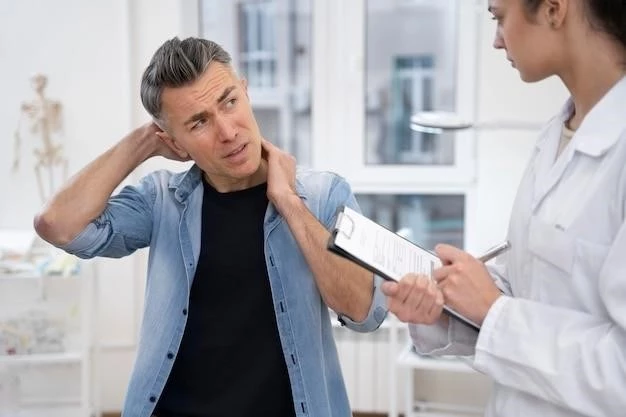DOPA-responsive dystonia
DOPA-responsive dystonia is a neurological disorder with a genetic basis․ This article will delve into the symptoms, effects on the brain, diagnosis, and treatment options including Levodopa medication․ Management strategies and ongoing research will also be discussed to provide a comprehensive overview of this condition․
Overview of DOPA-responsive Dystonia
DOPA-responsive dystonia, also known as Segawa syndrome, is a rare genetic disorder characterized by abnormal muscle contractions and involuntary movements․ This neurological condition typically presents in childhood or adolescence․ The primary cause of DOPA-responsive dystonia is a mutation in the GCH1 gene, which leads to a deficiency in the production of the neurotransmitter dopamine․ Dopamine is crucial for regulating movement and muscle control in the brain․
Individuals with DOPA-responsive dystonia often experience symptoms such as muscle stiffness, tremors, and difficulty initiating movements․ These symptoms may initially be misdiagnosed as cerebral palsy or other movement disorders․ However, a key feature of this disorder is a positive response to treatment with Levodopa, a medication that helps increase dopamine levels in the brain․
Understanding the genetic basis of DOPA-responsive dystonia is essential for accurate diagnosis and targeted treatment․ While the inheritance pattern of this disorder can vary, it is typically passed down in an autosomal dominant fashion․ Diagnosis often involves genetic testing to identify mutations in the GCH1 gene or a trial of Levodopa to assess the response․
Overall, DOPA-responsive dystonia poses significant challenges for affected individuals due to its impact on motor function and quality of life․ However, with appropriate diagnosis and tailored treatment approaches, including Levodopa therapy, many individuals with this condition can experience significant improvement in their symptoms and overall well-being․
Understanding the Genetic Basis
DOPA-responsive dystonia is primarily caused by mutations in the GCH1 gene, which encodes an enzyme involved in dopamine synthesis․ The mutations result in reduced enzymatic activity, leading to decreased dopamine production in the brain․ Dopamine plays a crucial role in controlling movement and muscle function, explaining the motor symptoms seen in individuals with this disorder․
The inheritance pattern of DOPA-responsive dystonia is typically autosomal dominant, meaning that an affected individual has a 50% chance of passing the mutated gene to their offspring․ In some cases, the condition can also arise from de novo mutations, where the genetic change occurs spontaneously in a person with no family history of the disorder․
Genetic testing is essential for confirming a diagnosis of DOPA-responsive dystonia by identifying mutations in the GCH1 gene․ This information not only helps in confirming the presence of the disorder but also guides treatment decisions․ Understanding the genetic basis of the condition is crucial for providing tailored and effective therapies, such as Levodopa medication, which targets the dopamine deficiency underlying the symptoms․
Research into the genetic mechanisms of DOPA-responsive dystonia continues to advance our understanding of the disease․ Identifying additional genetic factors and pathways involved in dopamine regulation may lead to new therapeutic targets and personalized treatment strategies․ By unraveling the genetic basis of this disorder, researchers aim to improve diagnostic accuracy, prognosis, and treatment outcomes for individuals affected by DOPA-responsive dystonia․
Symptoms and Effects on the Brain
DOPA-responsive dystonia manifests with a range of symptoms affecting movement and muscle control․ Common manifestations include muscle stiffness, tremors, dystonia (involuntary muscle contractions), and difficulty initiating or coordinating movements․ These motor symptoms often worsen with physical activity and stress, impacting daily functioning and quality of life․
One of the key effects of DOPA-responsive dystonia on the brain is the dysregulation of dopamine, a neurotransmitter essential for smooth motor function․ The reduced dopamine production resulting from mutations in the GCH1 gene leads to improper signaling in the basal ganglia, a brain region crucial for motor control․ This disruption in dopamine levels contributes to the characteristic movement abnormalities observed in affected individuals․
Beyond motor symptoms, DOPA-responsive dystonia can also present with non-motor features, including cognitive changes, mood disturbances, and autonomic dysfunction․ These additional symptoms can further impact the overall well-being of individuals with the disorder and may require comprehensive management strategies alongside motor symptom treatment․
Understanding the interplay between the disrupted dopamine pathways, brain function, and the diverse symptoms of DOPA-responsive dystonia is essential for developing targeted therapies․ By addressing both the motor and non-motor aspects of the condition, healthcare providers can enhance the quality of life for individuals living with this neurological disorder․ Ongoing research into the neurological effects of DOPA-responsive dystonia continues to shed light on the complex relationship between genetic mutations, neurotransmitter function, and brain abnormalities in this condition․
Diagnosis and Treatment Options
Diagnosing DOPA-responsive dystonia requires a comprehensive assessment that includes a thorough medical history, physical examination, and specialized tests․ Genetic testing plays a critical role in confirming the presence of mutations in the GCH1 gene, providing a definitive diagnosis․ Additionally, a trial of Levodopa medication can help clinicians evaluate the response to treatment, further supporting the diagnosis․
Once diagnosed, individuals with DOPA-responsive dystonia have various treatment options aimed at managing symptoms and improving quality of life․ The mainstay of treatment is Levodopa, a medication that can effectively increase dopamine levels in the brain and alleviate motor symptoms․ Dosages may need to be carefully adjusted to achieve optimal symptom control while minimizing side effects․
Physical therapy and muscle relaxants are often used in conjunction with medication to address muscle stiffness, improve mobility, and enhance motor function․ Occupational therapy may also be beneficial in optimizing daily activities and promoting independence․ Regular monitoring by a multidisciplinary team of healthcare professionals is essential to track treatment response and adjust interventions as needed․
In cases where symptoms are severe or do not adequately respond to initial treatments, deep brain stimulation (DBS) surgery may be considered․ DBS involves implanting electrodes in specific brain regions to modulate abnormal neural activity and improve motor function․ This surgical intervention is reserved for individuals who have not experienced sufficient relief from medication and therapy․
Overall, the management of DOPA-responsive dystonia requires a personalized approach that considers the individual’s unique symptoms, treatment response, and quality of life goals․ By combining pharmacological interventions, therapy, and potentially surgical options, healthcare providers can help individuals with this disorder effectively manage their symptoms and enhance their overall well-being․
Management and Therapy
The management of DOPA-responsive dystonia involves a multifaceted approach aimed at addressing both motor and non-motor symptoms to improve overall quality of life for affected individuals․ Pharmacological therapy with Levodopa is a cornerstone in symptom management, targeting the underlying dopamine deficiency in the brain to alleviate movement abnormalities․
Physical therapy plays a crucial role in the management of DOPA-responsive dystonia by focusing on improving muscle control, flexibility, and coordination․ Exercise regimens tailored to the individual’s needs can help enhance mobility, reduce muscle stiffness, and optimize functional abilities․ Different modalities such as stretching exercises, gait training, and balance exercises are often employed to address specific motor challenges․
Occupational therapy is essential for individuals with DOPA-responsive dystonia to enhance daily living skills, promote independence, and facilitate participation in meaningful activities․ Occupational therapists work with patients to improve fine motor skills, develop adaptive strategies, and address limitations related to daily tasks such as dressing, grooming, and meal preparation․
Psychological support and counseling play a significant role in the holistic management of DOPA-responsive dystonia by addressing emotional well-being, coping strategies, and mental health challenges that may arise due to the chronic nature of the disorder․ Support groups and mental health professionals can provide valuable resources and guidance for both individuals with the condition and their families․
Regular follow-up appointments with a multidisciplinary healthcare team are essential to monitor treatment effectiveness, adjust medications as needed, and address any new symptoms or concerns․ By combining pharmacological interventions, therapy, and psychosocial support, individuals with DOPA-responsive dystonia can optimize their quality of life and functional abilities while managing the challenges associated with this neurological disorder․
Future Research and Outlook
Future research in the field of DOPA-responsive dystonia holds promise for advancing our understanding of the disease mechanisms, improving diagnostic tools, and developing novel treatment strategies․ Scientists are exploring the intricate interplay between genetic mutations, dopamine dysregulation, and brain circuitry to unravel the complex pathophysiology of this condition․
Advances in genetic testing technologies are enabling researchers to identify additional genetic factors that may influence the clinical presentation and progression of DOPA-responsive dystonia․ By elucidating genetic modifiers and other contributing factors, researchers aim to enhance the accuracy of diagnosis, refine prognostic indicators, and tailor treatment approaches to individual patients․
Novel therapeutic approaches, including gene therapy and targeted drug development, are being investigated as potential treatment options for DOPA-responsive dystonia․ These cutting-edge interventions hold the potential to address the underlying genetic defects and restore normal dopamine function in the brain, offering new hope for individuals living with this rare neurological disorder․

Beyond pharmacological and genetic interventions, researchers are exploring innovative technologies such as deep brain stimulation (DBS) and non-invasive neuromodulation techniques to modulate neural activity and improve motor function in individuals with DOPA-responsive dystonia․ These neurostimulation approaches show promise in providing additional treatment options for individuals who may not respond optimally to traditional therapies․
Overall, the outlook for individuals with DOPA-responsive dystonia is optimistic, with ongoing research efforts aimed at advancing our knowledge of the disease and developing novel therapeutic interventions; By harnessing the power of genetics, neuroscience, and clinical innovation, researchers are paving the way for improved outcomes, personalized treatment strategies, and ultimately a better quality of life for individuals affected by this complex neurological disorder․
